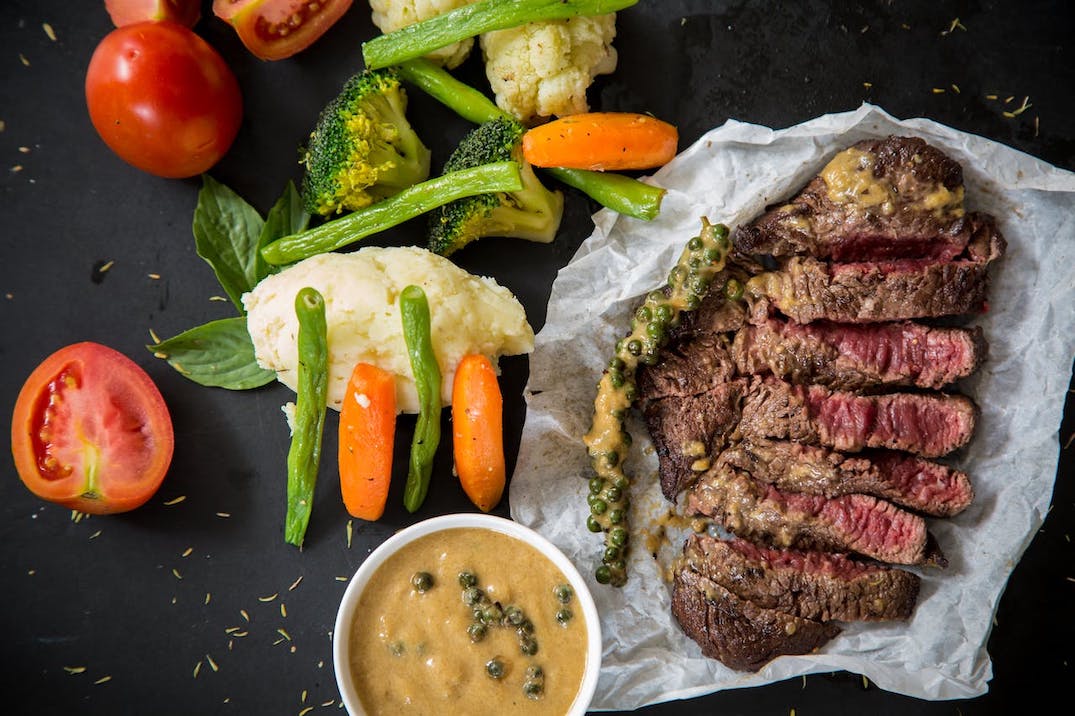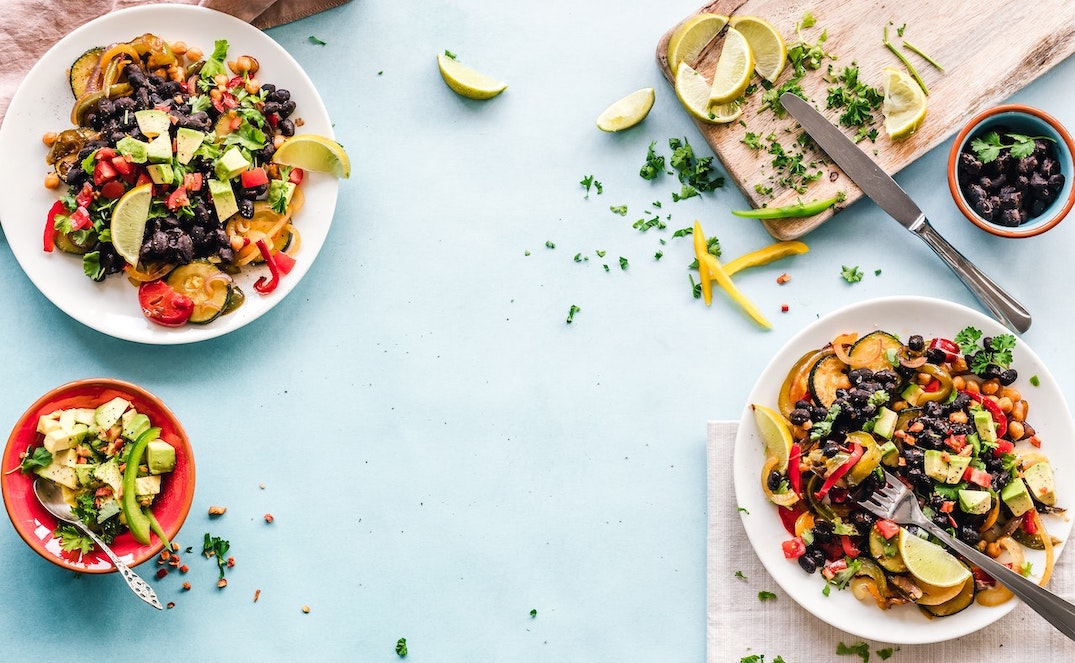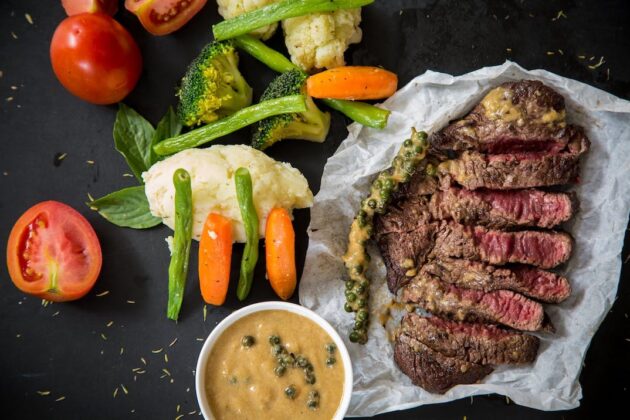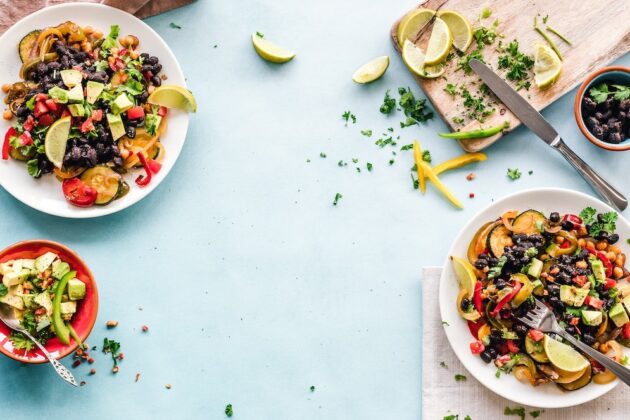Mounjaro Diet Plan: Best Foods to Eat & Which to Avoid (with printable PDF)
If you recently started taking Mounjaro, a once-weekly injectable diabetes medication, you may be looking for the best diet plan to maximize your results.
Mounjaro (generic name tirzepatide) is used to lower blood sugar in adults with type 2 diabetes mellitus. It can also help you lose weight. Mounjaro works by mimicking two naturally occurring hormones (GIP and GLP-1) that help lower your blood sugar and decrease your appetite.
But just taking Mounjaro is not enough.
You have to follow a healthy diet while taking Mounjaro to see the best results. This includes eating nutrient-rich foods like lean proteins, whole grains, and non-starchy vegetables. You also want to avoid foods that are fried, high in sugar, and highly processed as they can worsen side effects or slow your success.
This guide goes over what a healthy Mounjaro diet plan looks like, including the best foods to eat, which to avoid, a PDF of the Mounjaro meal plan, and more.

Reach your weight loss goals faster with support from a Registered Dietitian
90% of Zaya Care patients pay $0 for one-on-one counseling with an RD
Mounjaro diet overview
Mounjaro is intended to be used along with a healthy diet and exercise routine.
While there isn’t a specific Mounjaro diet plan, following a generally healthy diet is recommended. This is because a well-balanced diet will help you achieve better blood sugar control and more significant weight loss.
A healthy, well-balanced diet includes a variety of foods from different food groups. These food groups include lean protein, low-fat dairy, whole grains, healthy fats, fruits, and vegetables.
There are also certain foods you should avoid while taking Mounjaro, including sugary foods and drinks, fried foods, high-sodium foods, artificial sweeteners, and alcohol.
In addition to eating well, staying hydrated, exercising, and getting enough sleep can also help with weight management and blood sugar levels. By maintaining a healthy diet and lifestyle on Mounjaro, you’ll set yourself up for sustainable, long-term success.
Best foods to eat on Mounjaro
The best foods to eat on Mounjaro are nutrient-rich foods. Each meal should include a combination of lean protein, fiber, and healthy fats to keep you feeling full and satisfied. Here is a list of the best foods to eat on Mounjaro.
- Lean proteins. The amount of protein you need depends on your age, weight, sex, and activity level. Lean protein options include skinless poultry, fish, egg whites, tofu, and beans.
- Whole grains. Whole grains keep you feeling fuller than refined carbohydrates. This is because they are higher in fiber. Examples of whole grains include whole wheat pasta, brown rice, oats, barley, and quinoa.
- Non-starchy vegetables. Non-starchy vegetables are better for weight and blood sugar control because they only contain about 5 grams of carbohydrates per serving. Some common non-starchy vegetables include asparagus, broccoli, cauliflower, green beans, leafy greens, cucumbers, and carrots.
- Fruits. Fruit is full of fiber, vitamins, and minerals. It’s best to choose fresh fruit or frozen fruit made without added sugar. Blueberries, raspberries, strawberries, apples, pears, and citrus fruits are all excellent options.
- Healthy fats. Healthy fats include monounsaturated fat and polyunsaturated fat. These healthy fats are found in foods like olive oil, avocado oil, fatty fish, nuts, seeds, and whole grains.
- Nuts & seeds. Both nuts and seeds are good sources of healthy fats, protein, fiber, vitamins, and minerals. However, they are high in calories, so it’s important to watch your portion size. Examples include walnuts, almonds, pumpkin seeds, and sunflower seeds.
- Legumes & beans. Legumes and beans are packed with fiber and plant-based protein. Including foods like lentils, split peas, black beans, chickpeas, and edamame in your diet can help you lose weight more easily.
- Dairy & dairy alternatives. Low-fat dairy products are a good source of protein and can help you lose weight. Some options include milk, yogurt, cheese, and dairy-free alternatives like soy milk.
- Fermented foods. Fermentation happens when good bacteria break down sugar in foods. These good bacteria are thought to increase the amount of healthy bacteria in the gut and help with weight management. Examples of fermented foods include kefir, sauerkraut, kimchi, kombucha, tempeh, and miso.
Foods to avoid on Mounjaro
While there are a variety of healthy options to choose from, there are also some foods you should avoid while taking Mounjaro. Here is a list of foods to limit from your Mounjaro diet plan if you want to see the best results.
- Sugary foods & drinks. Sugary foods like baked goods, desserts, and candy, as well as sugary drinks like soda, energy drinks, and juices, should be avoided. These contribute to excess calories without providing nutritional benefits.
- Fried foods. Fried foods are high in unhealthy fats and calories. They are best avoided while taking Mounjaro. Examples of fried foods include French fries, onion rings, fish and chips, and fried chicken tenders.
- Refined carbohydrates. Refined carbohydrates like white bread, pasta, and rice, are low in fiber. Eating too much of these foods contributes to weight gain.
- Ultra-processed foods. Ultra-processed foods are generally lower in nutritional value and higher in added sugar, salt, and bad fats. Packaged foods like frozen meals, chicken nuggets, sweetened breakfast cereals, and canned soups are considered ultra-processed.
- Fatty meats. Fatty meats, like marbled beef, pork belly, ribs, bacon, sausage, and hot dogs, are high in saturated fat and contribute to excess calorie intake.
- Foods high in sodium. Sodium is mostly found in processed foods and restaurant foods. Some examples of high-sodium foods include pizza, burgers, burritos, bread, cheese, and chips.
- Artificial sweeteners. Contrary to popular belief, eating foods with artificial sweeteners, like aspartame and sucralose, is thought to lead to weight gain. Some common foods that include artificial sweeteners are diet soda, yogurt, desserts, and bread products.
- Alcohol. Alcohol is high in calories and low in nutrients. It’s best to avoid drinking alcohol while trying to lose weight.

Reach your weight loss goals faster with support from a Registered Dietitian
90% of Zaya Care patients pay $0 for one-on-one counseling with an RD
Example Mounjaro diet plan
Here is a sample 1,600-calorie diet plan that includes many of the best foods to eat while taking Mounjaro listed above. Note that your ideal Mounjaro diet depends on your personal situation, including weight, food preferences/intolerances, and more.
You can also download a printable PDF version of our sample Mounjaro meal plan here.
Breakfast (400 calories)
- Oatmeal with Berries and Nuts
- Cooked oatmeal (1 cup): 150 calories
- Fresh berries (1/2 cup): 40 calories
- Chopped almonds (1 tbsp): 50 calories
- A drizzle of honey (1 tsp): 20 calories
- Skim milk (1/2 cup): 40 calories
Mid-Morning Snack (100 calories)
- Greek Yogurt
- Non-fat Greek yogurt (1/2 cup): 100 calories
Lunch (400 calories)
- Grilled Chicken Salad
- Grilled chicken breast (100g): 165 calories
- Mixed greens (2 cups): 20 calories
- Cherry tomatoes (1/2 cup): 15 calories
- Cucumber slices (1/2 cup): 8 calories
- Carrot sticks (1/2 cup): 25 calories
- Balsamic vinaigrette (1 tbsp): 45 calories
- Whole grain bread slice: 70 calories
Afternoon Snack (200 calories)
- Fruit and Nuts
- Apple (1 medium): 95 calories
- Walnuts (10 halves): 105 calories
Dinner (500 calories)
- Baked Salmon with Vegetables
- Baked salmon fillet (150g): 280 calories
- Steamed broccoli (1 cup): 55 calories
- Quinoa (1/2 cup cooked): 111 calories
- Lemon wedge for flavor: 5 calories
Evening Snack (100 calories)
- Carrot and Hummus
- Baby carrots (10): 40 calories
- Hummus (2 tbsp): 60 calories
Other tips for having a healthy lifestyle & diet on Mounjaro
A healthy lifestyle and diet are more than just the individual foods you eat. Many other habits contribute to your overall well-being. Here are some additional healthy eating and lifestyle tips to help you make the most of your Mounjaro diet plan.
- Eat balanced meals. A balanced meal is made up of foods that contain lean protein, fiber, and healthy fats. Eating balanced meals keeps you feeling fuller for longer, which helps you eat less overall.
- Eat slowly & mindfully. Eating slowly gives your brain a chance to catch up to how your stomach is feeling. To eat more mindfully, try putting your fork down between bites and not eating in front of the TV or your phone. You’ll start noticing more easily when you feel full.
- Control portion sizes. Eating smaller portions can help you lose weight and manage your blood sugar more easily. It can also help prevent some of the more common gastrointestinal side effects of Mounjaro.
- Stay hydrated. Staying hydrated keeps your body feeling its best. In particular, drinking enough water can help you reduce your calorie intake, especially if you swap it for sugary drinks.
- Don’t forget about protein. Protein is important for building lean muscle and weight loss. It also keeps you feeling full after a meal because it digests slowly. Aim to eat one protein-rich food like meat, seafood, or legumes with every meal.
- Learn to read food labels. Food labels tell you the serving size of packaged foods along with the number of calories and other nutrients found in each serving. Learning how to read food labels will help you make informed decisions about the food you’re eating.
- Cook at home more often. When you cook at home, you have more control over the ingredients you’re eating. Home-cooked meals are often lower in sodium, fat, and calories than restaurant meals or prepared meals.
- Avoid crash diets & other unhealthy eating patterns. Crash diets and other extreme diets are typically very low in calories, fats, or carbohydrates. They are not a good choice for long-term weight loss. Any weight that is lost is often gained back as soon as you stop the diet.
- Work out regularly. Finding a workout routine you can stick to isn’t just about burning calories. Regular exercise can also help decrease appetite and reduce blood sugar.
- Get plenty of sleep. Not getting enough sleep makes diabetes harder to manage. When your energy levels are low, you’re more likely to eat high-calorie foods. This makes it harder to lose weight and keep your blood sugar in check.
- Consider working with a dietitian. A dietitian can help you stay on track with a diet plan that works for you. We’ll talk more about why you should consider working with a dietitian in the next section.
Why you should consider working with a dietitian while taking Mounjaro
There are many reasons why working with a dietitian is helpful, especially when taking a medication like Mounjaro. Mounjaro works best when combined with a healthy diet and exercise plan. Without these lifestyle changes, you may not see all the potential benefits of Mounjaro.
A dietitian can teach you how to eat to control your blood sugar and lose weight. They are trained to help you create a diet plan that is tailored to your specific food preferences. They will also help you meet your unique nutritional needs.
Another benefit of working with a dietitian is managing any potential side effects that may occur. The most common potential side effects of Mounjaro include nausea, diarrhea, vomiting, and constipation. A dietitian can help you choose foods that reduce or eliminate these side effects.
Overall, working with a dietitian while taking Mounjaro will give you the best chance at long-term success.
Here at Zaya Care, we’re dedicated to helping people find the care they need based on their preferences, needs, and insurance. Many dietitians are covered by insurance.
When you request an appointment with one of our Registered Dietitians, we’ll check your insurance so you know exactly how much you’ll have to pay, if anything at all.
It’s worth noting that 90% of Zaya Care patients pay $0 for nutrition care with a registered dietitian as we are in-network with many major carriers.

Reach your weight loss goals faster with support from a Registered Dietitian
90% of Zaya Care patients pay $0 for one-on-one counseling with an RD
How Mounjaro works & can help with weight loss
As mentioned previously, Mounjaro can help you lose weight. It does this in two different ways.
When you eat, your body releases hormones that help control your appetite. Mounjaro mimics these naturally occurring hormones, sending signals to your brain that your stomach is fuller sooner than normal.
Mounjaro also slows down how quickly food travels through your digestive system. This is called delayed gastric emptying. Delayed gastric emptying may cause you to feel fuller for longer, decreasing your appetite overall.
But does Mounjaro make you not want to eat?
While Mounjaro does decrease your appetite, it shouldn’t make you not want to eat at all. If you’re concerned your low appetite is affecting your ability to eat enough nutritious food, consider talking with a dietitian to help manage your diet.
Mounjaro’s interactions with other medications
Most medications are safe to take with Mounjaro. However, it may interact with certain diabetes medications. Additionally, because your stomach empties more slowly on Mounjaro, it may cause some medications to be less effective.
Taking certain diabetes medications or insulin along with Mounjaro may cause low blood sugar. This is because Mounjaro helps your body release insulin. If too much insulin is present in your body, low blood sugar can occur.
Mounjaro also affects how your body absorbs medications that you take by mouth. This is due to your stomach emptying more slowly than usual. Some notable medications that may be less effective when taken with Mounjaro include birth control pills, warfarin, and acetaminophen.
Common over-the-counter medications, like those taken for pain relief, allergies, or stomach problems, are generally safe to take with Mounjaro. However, it is important to note that they may be less effective.
You should always let your doctor know about any changes to the prescription or over-the-counter medications you’re taking so they can check for potential interactions.
>> Read More: What happens when you stop taking Mounjaro?
Mounjaro’s interactions with supplements
Dietary supplements include vitamins, minerals, herbs, botanicals, and amino acids. They are typically taken by mouth. If you take any supplements, you may be wondering how they interact with Mounjaro.
Information about how supplements interact with Mounjaro is limited. However, some supplements may increase your risk of experiencing low blood sugar when taken with Mounjaro.
Some herbs are thought to help lower blood sugar levels including bitter melon, fenugreek, cinnamon, ginseng, and prickly pear cactus, among others. If you take any herbal supplements to help control your blood sugar levels, check with your doctor to make sure they’re safe to continue with Mounjaro.
The mineral chromium may also interact with Mounjaro. Chromium has been shown to reduce blood sugar levels. Therefore, taking Mounjaro with chromium may lead to low blood sugar.
If you’re concerned about whether the supplements you take interact with Mounjaro, talk to your doctor.
Side effects of Mounjaro
While Mounjaro is beneficial and safe for most people who take it, there are some possible side effects to consider. The most common side effects of Mounjaro involve your digestive system. These side effects typically occur while the dose is being increased and usually decrease over time.
Other, more serious side effects are less common but may require medical attention. Below are some of the most common side effects to watch out for while taking Mounjaro.
- Nausea. Nausea is the most common side effect of Mounjaro with higher doses making this side effect more likely to occur. If you experience nausea while taking Mounjaro, it is recommended to eat smaller meals and bland foods, avoid fatty foods, and stop eating when you feel full.
- Diarrhea. Another common side effect of Mounjaro is diarrhea. If you experience diarrhea, it’s important to drink plenty of fluids to avoid becoming dehydrated, especially if you have kidney problems.
- Decreased appetite. The way Mounjaro works may cause you to have a decreased appetite while taking it. This side effect may be beneficial if losing weight is part of your treatment plan. However, it’s important to continue to eat a nutritious and balanced diet.
- Vomiting. Vomiting may occur while taking Mounjaro, particularly with higher doses. This symptom usually subsides over time. However, if you experience vomiting and severe stomach pains that won’t go away, you may have a more serious condition called pancreatitis.
- Other digestive issues. Other digestive issues that are common on Mounjaro include constipation, indigestion, and stomach pains. Like the other side effects involving the digestive system, these issues often resolve on their own over time.
- Pancreatitis. Pancreatitis occurs when the pancreas becomes inflamed, which may occur if there are high levels of fat in your blood. Signs of pancreatitis include severe upper abdominal pain, nausea, and vomiting.
- Low blood sugar. People who take other medications to help control their diabetes in addition to Mounjaro are at a higher risk of experiencing episodes of low blood sugar (hypoglycemia). Signs of low blood sugar include fast heartbeat, shaking, sweating, dizziness, and confusion.
- Kidney problems. If you experience nausea, vomiting, and diarrhea while taking Mounjaro, you may be at an increased risk for kidney problems. This is because these gastrointestinal side effects can lead to dehydration, which damages the kidneys.
- Allergic reaction. Allergic reactions can occur when taking Mounjaro, especially if you’ve had a reaction to medications like Mounjaro in the past. Signs of an allergic reaction include swelling of your lips, tongue, or throat, trouble breathing, rash, dizziness, and a rapid heartbeat.
- Thyroid tumors. Tirzepatide, the active ingredient in Mounjaro, was shown to cause thyroid tumors in rats. While it is not known if this same effect occurs in humans, the FDA issued a boxed warning for Mounjaro.

Reach your weight loss goals faster with support from a Registered Dietitian
90% of Zaya Care patients pay $0 for one-on-one counseling with an RD
If you recently started taking Mounjaro, a once-weekly injectable diabetes medication, you may be looking for the best diet plan to maximize your results.
Mounjaro (generic name tirzepatide) is used to lower blood sugar in adults with type 2 diabetes mellitus. It can also help you lose weight. Mounjaro works by mimicking two naturally occurring hormones (GIP and GLP-1) that help lower your blood sugar and decrease your appetite.
But just taking Mounjaro is not enough.
You have to follow a healthy diet while taking Mounjaro to see the best results. This includes eating nutrient-rich foods like lean proteins, whole grains, and non-starchy vegetables. You also want to avoid foods that are fried, high in sugar, and highly processed as they can worsen side effects or slow your success.
This guide goes over what a healthy Mounjaro diet plan looks like, including the best foods to eat, which to avoid, a PDF of the Mounjaro meal plan, and more.

Reach your weight loss goals faster with support from a Registered Dietitian
90% of Zaya Care patients pay $0 for one-on-one counseling with an RD
Mounjaro diet overview
Mounjaro is intended to be used along with a healthy diet and exercise routine.
While there isn’t a specific Mounjaro diet plan, following a generally healthy diet is recommended. This is because a well-balanced diet will help you achieve better blood sugar control and more significant weight loss.
A healthy, well-balanced diet includes a variety of foods from different food groups. These food groups include lean protein, low-fat dairy, whole grains, healthy fats, fruits, and vegetables.
There are also certain foods you should avoid while taking Mounjaro, including sugary foods and drinks, fried foods, high-sodium foods, artificial sweeteners, and alcohol.
In addition to eating well, staying hydrated, exercising, and getting enough sleep can also help with weight management and blood sugar levels. By maintaining a healthy diet and lifestyle on Mounjaro, you’ll set yourself up for sustainable, long-term success.
Best foods to eat on Mounjaro
The best foods to eat on Mounjaro are nutrient-rich foods. Each meal should include a combination of lean protein, fiber, and healthy fats to keep you feeling full and satisfied. Here is a list of the best foods to eat on Mounjaro.
- Lean proteins. The amount of protein you need depends on your age, weight, sex, and activity level. Lean protein options include skinless poultry, fish, egg whites, tofu, and beans.
- Whole grains. Whole grains keep you feeling fuller than refined carbohydrates. This is because they are higher in fiber. Examples of whole grains include whole wheat pasta, brown rice, oats, barley, and quinoa.
- Non-starchy vegetables. Non-starchy vegetables are better for weight and blood sugar control because they only contain about 5 grams of carbohydrates per serving. Some common non-starchy vegetables include asparagus, broccoli, cauliflower, green beans, leafy greens, cucumbers, and carrots.
- Fruits. Fruit is full of fiber, vitamins, and minerals. It’s best to choose fresh fruit or frozen fruit made without added sugar. Blueberries, raspberries, strawberries, apples, pears, and citrus fruits are all excellent options.
- Healthy fats. Healthy fats include monounsaturated fat and polyunsaturated fat. These healthy fats are found in foods like olive oil, avocado oil, fatty fish, nuts, seeds, and whole grains.
- Nuts & seeds. Both nuts and seeds are good sources of healthy fats, protein, fiber, vitamins, and minerals. However, they are high in calories, so it’s important to watch your portion size. Examples include walnuts, almonds, pumpkin seeds, and sunflower seeds.
- Legumes & beans. Legumes and beans are packed with fiber and plant-based protein. Including foods like lentils, split peas, black beans, chickpeas, and edamame in your diet can help you lose weight more easily.
- Dairy & dairy alternatives. Low-fat dairy products are a good source of protein and can help you lose weight. Some options include milk, yogurt, cheese, and dairy-free alternatives like soy milk.
- Fermented foods. Fermentation happens when good bacteria break down sugar in foods. These good bacteria are thought to increase the amount of healthy bacteria in the gut and help with weight management. Examples of fermented foods include kefir, sauerkraut, kimchi, kombucha, tempeh, and miso.
Foods to avoid on Mounjaro
While there are a variety of healthy options to choose from, there are also some foods you should avoid while taking Mounjaro. Here is a list of foods to limit from your Mounjaro diet plan if you want to see the best results.
- Sugary foods & drinks. Sugary foods like baked goods, desserts, and candy, as well as sugary drinks like soda, energy drinks, and juices, should be avoided. These contribute to excess calories without providing nutritional benefits.
- Fried foods. Fried foods are high in unhealthy fats and calories. They are best avoided while taking Mounjaro. Examples of fried foods include French fries, onion rings, fish and chips, and fried chicken tenders.
- Refined carbohydrates. Refined carbohydrates like white bread, pasta, and rice, are low in fiber. Eating too much of these foods contributes to weight gain.
- Ultra-processed foods. Ultra-processed foods are generally lower in nutritional value and higher in added sugar, salt, and bad fats. Packaged foods like frozen meals, chicken nuggets, sweetened breakfast cereals, and canned soups are considered ultra-processed.
- Fatty meats. Fatty meats, like marbled beef, pork belly, ribs, bacon, sausage, and hot dogs, are high in saturated fat and contribute to excess calorie intake.
- Foods high in sodium. Sodium is mostly found in processed foods and restaurant foods. Some examples of high-sodium foods include pizza, burgers, burritos, bread, cheese, and chips.
- Artificial sweeteners. Contrary to popular belief, eating foods with artificial sweeteners, like aspartame and sucralose, is thought to lead to weight gain. Some common foods that include artificial sweeteners are diet soda, yogurt, desserts, and bread products.
- Alcohol. Alcohol is high in calories and low in nutrients. It’s best to avoid drinking alcohol while trying to lose weight.

Reach your weight loss goals faster with support from a Registered Dietitian
90% of Zaya Care patients pay $0 for one-on-one counseling with an RD
Example Mounjaro diet plan
Here is a sample 1,600-calorie diet plan that includes many of the best foods to eat while taking Mounjaro listed above. Note that your ideal Mounjaro diet depends on your personal situation, including weight, food preferences/intolerances, and more.
You can also download a printable PDF version of our sample Mounjaro meal plan here.
Breakfast (400 calories)
- Oatmeal with Berries and Nuts
- Cooked oatmeal (1 cup): 150 calories
- Fresh berries (1/2 cup): 40 calories
- Chopped almonds (1 tbsp): 50 calories
- A drizzle of honey (1 tsp): 20 calories
- Skim milk (1/2 cup): 40 calories
Mid-Morning Snack (100 calories)
- Greek Yogurt
- Non-fat Greek yogurt (1/2 cup): 100 calories
Lunch (400 calories)
- Grilled Chicken Salad
- Grilled chicken breast (100g): 165 calories
- Mixed greens (2 cups): 20 calories
- Cherry tomatoes (1/2 cup): 15 calories
- Cucumber slices (1/2 cup): 8 calories
- Carrot sticks (1/2 cup): 25 calories
- Balsamic vinaigrette (1 tbsp): 45 calories
- Whole grain bread slice: 70 calories
Afternoon Snack (200 calories)
- Fruit and Nuts
- Apple (1 medium): 95 calories
- Walnuts (10 halves): 105 calories
Dinner (500 calories)
- Baked Salmon with Vegetables
- Baked salmon fillet (150g): 280 calories
- Steamed broccoli (1 cup): 55 calories
- Quinoa (1/2 cup cooked): 111 calories
- Lemon wedge for flavor: 5 calories
Evening Snack (100 calories)
- Carrot and Hummus
- Baby carrots (10): 40 calories
- Hummus (2 tbsp): 60 calories
Other tips for having a healthy lifestyle & diet on Mounjaro
A healthy lifestyle and diet are more than just the individual foods you eat. Many other habits contribute to your overall well-being. Here are some additional healthy eating and lifestyle tips to help you make the most of your Mounjaro diet plan.
- Eat balanced meals. A balanced meal is made up of foods that contain lean protein, fiber, and healthy fats. Eating balanced meals keeps you feeling fuller for longer, which helps you eat less overall.
- Eat slowly & mindfully. Eating slowly gives your brain a chance to catch up to how your stomach is feeling. To eat more mindfully, try putting your fork down between bites and not eating in front of the TV or your phone. You’ll start noticing more easily when you feel full.
- Control portion sizes. Eating smaller portions can help you lose weight and manage your blood sugar more easily. It can also help prevent some of the more common gastrointestinal side effects of Mounjaro.
- Stay hydrated. Staying hydrated keeps your body feeling its best. In particular, drinking enough water can help you reduce your calorie intake, especially if you swap it for sugary drinks.
- Don’t forget about protein. Protein is important for building lean muscle and weight loss. It also keeps you feeling full after a meal because it digests slowly. Aim to eat one protein-rich food like meat, seafood, or legumes with every meal.
- Learn to read food labels. Food labels tell you the serving size of packaged foods along with the number of calories and other nutrients found in each serving. Learning how to read food labels will help you make informed decisions about the food you’re eating.
- Cook at home more often. When you cook at home, you have more control over the ingredients you’re eating. Home-cooked meals are often lower in sodium, fat, and calories than restaurant meals or prepared meals.
- Avoid crash diets & other unhealthy eating patterns. Crash diets and other extreme diets are typically very low in calories, fats, or carbohydrates. They are not a good choice for long-term weight loss. Any weight that is lost is often gained back as soon as you stop the diet.
- Work out regularly. Finding a workout routine you can stick to isn’t just about burning calories. Regular exercise can also help decrease appetite and reduce blood sugar.
- Get plenty of sleep. Not getting enough sleep makes diabetes harder to manage. When your energy levels are low, you’re more likely to eat high-calorie foods. This makes it harder to lose weight and keep your blood sugar in check.
- Consider working with a dietitian. A dietitian can help you stay on track with a diet plan that works for you. We’ll talk more about why you should consider working with a dietitian in the next section.
Why you should consider working with a dietitian while taking Mounjaro
There are many reasons why working with a dietitian is helpful, especially when taking a medication like Mounjaro. Mounjaro works best when combined with a healthy diet and exercise plan. Without these lifestyle changes, you may not see all the potential benefits of Mounjaro.
A dietitian can teach you how to eat to control your blood sugar and lose weight. They are trained to help you create a diet plan that is tailored to your specific food preferences. They will also help you meet your unique nutritional needs.
Another benefit of working with a dietitian is managing any potential side effects that may occur. The most common potential side effects of Mounjaro include nausea, diarrhea, vomiting, and constipation. A dietitian can help you choose foods that reduce or eliminate these side effects.
Overall, working with a dietitian while taking Mounjaro will give you the best chance at long-term success.
Here at Zaya Care, we’re dedicated to helping people find the care they need based on their preferences, needs, and insurance. Many dietitians are covered by insurance.
When you request an appointment with one of our Registered Dietitians, we’ll check your insurance so you know exactly how much you’ll have to pay, if anything at all.
It’s worth noting that 90% of Zaya Care patients pay $0 for nutrition care with a registered dietitian as we are in-network with many major carriers.

Reach your weight loss goals faster with support from a Registered Dietitian
90% of Zaya Care patients pay $0 for one-on-one counseling with an RD
How Mounjaro works & can help with weight loss
As mentioned previously, Mounjaro can help you lose weight. It does this in two different ways.
When you eat, your body releases hormones that help control your appetite. Mounjaro mimics these naturally occurring hormones, sending signals to your brain that your stomach is fuller sooner than normal.
Mounjaro also slows down how quickly food travels through your digestive system. This is called delayed gastric emptying. Delayed gastric emptying may cause you to feel fuller for longer, decreasing your appetite overall.
But does Mounjaro make you not want to eat?
While Mounjaro does decrease your appetite, it shouldn’t make you not want to eat at all. If you’re concerned your low appetite is affecting your ability to eat enough nutritious food, consider talking with a dietitian to help manage your diet.
Mounjaro’s interactions with other medications
Most medications are safe to take with Mounjaro. However, it may interact with certain diabetes medications. Additionally, because your stomach empties more slowly on Mounjaro, it may cause some medications to be less effective.
Taking certain diabetes medications or insulin along with Mounjaro may cause low blood sugar. This is because Mounjaro helps your body release insulin. If too much insulin is present in your body, low blood sugar can occur.
Mounjaro also affects how your body absorbs medications that you take by mouth. This is due to your stomach emptying more slowly than usual. Some notable medications that may be less effective when taken with Mounjaro include birth control pills, warfarin, and acetaminophen.
Common over-the-counter medications, like those taken for pain relief, allergies, or stomach problems, are generally safe to take with Mounjaro. However, it is important to note that they may be less effective.
You should always let your doctor know about any changes to the prescription or over-the-counter medications you’re taking so they can check for potential interactions.
>> Read More: What happens when you stop taking Mounjaro?
Mounjaro’s interactions with supplements
Dietary supplements include vitamins, minerals, herbs, botanicals, and amino acids. They are typically taken by mouth. If you take any supplements, you may be wondering how they interact with Mounjaro.
Information about how supplements interact with Mounjaro is limited. However, some supplements may increase your risk of experiencing low blood sugar when taken with Mounjaro.
Some herbs are thought to help lower blood sugar levels including bitter melon, fenugreek, cinnamon, ginseng, and prickly pear cactus, among others. If you take any herbal supplements to help control your blood sugar levels, check with your doctor to make sure they’re safe to continue with Mounjaro.
The mineral chromium may also interact with Mounjaro. Chromium has been shown to reduce blood sugar levels. Therefore, taking Mounjaro with chromium may lead to low blood sugar.
If you’re concerned about whether the supplements you take interact with Mounjaro, talk to your doctor.
Side effects of Mounjaro
While Mounjaro is beneficial and safe for most people who take it, there are some possible side effects to consider. The most common side effects of Mounjaro involve your digestive system. These side effects typically occur while the dose is being increased and usually decrease over time.
Other, more serious side effects are less common but may require medical attention. Below are some of the most common side effects to watch out for while taking Mounjaro.
- Nausea. Nausea is the most common side effect of Mounjaro with higher doses making this side effect more likely to occur. If you experience nausea while taking Mounjaro, it is recommended to eat smaller meals and bland foods, avoid fatty foods, and stop eating when you feel full.
- Diarrhea. Another common side effect of Mounjaro is diarrhea. If you experience diarrhea, it’s important to drink plenty of fluids to avoid becoming dehydrated, especially if you have kidney problems.
- Decreased appetite. The way Mounjaro works may cause you to have a decreased appetite while taking it. This side effect may be beneficial if losing weight is part of your treatment plan. However, it’s important to continue to eat a nutritious and balanced diet.
- Vomiting. Vomiting may occur while taking Mounjaro, particularly with higher doses. This symptom usually subsides over time. However, if you experience vomiting and severe stomach pains that won’t go away, you may have a more serious condition called pancreatitis.
- Other digestive issues. Other digestive issues that are common on Mounjaro include constipation, indigestion, and stomach pains. Like the other side effects involving the digestive system, these issues often resolve on their own over time.
- Pancreatitis. Pancreatitis occurs when the pancreas becomes inflamed, which may occur if there are high levels of fat in your blood. Signs of pancreatitis include severe upper abdominal pain, nausea, and vomiting.
- Low blood sugar. People who take other medications to help control their diabetes in addition to Mounjaro are at a higher risk of experiencing episodes of low blood sugar (hypoglycemia). Signs of low blood sugar include fast heartbeat, shaking, sweating, dizziness, and confusion.
- Kidney problems. If you experience nausea, vomiting, and diarrhea while taking Mounjaro, you may be at an increased risk for kidney problems. This is because these gastrointestinal side effects can lead to dehydration, which damages the kidneys.
- Allergic reaction. Allergic reactions can occur when taking Mounjaro, especially if you’ve had a reaction to medications like Mounjaro in the past. Signs of an allergic reaction include swelling of your lips, tongue, or throat, trouble breathing, rash, dizziness, and a rapid heartbeat.
- Thyroid tumors. Tirzepatide, the active ingredient in Mounjaro, was shown to cause thyroid tumors in rats. While it is not known if this same effect occurs in humans, the FDA issued a boxed warning for Mounjaro.

Reach your weight loss goals faster with support from a Registered Dietitian
90% of Zaya Care patients pay $0 for one-on-one counseling with an RD
















